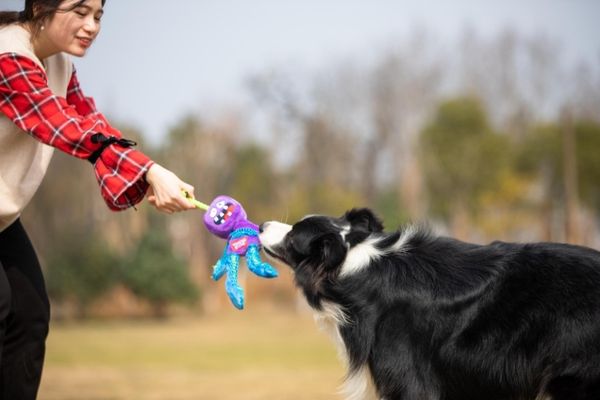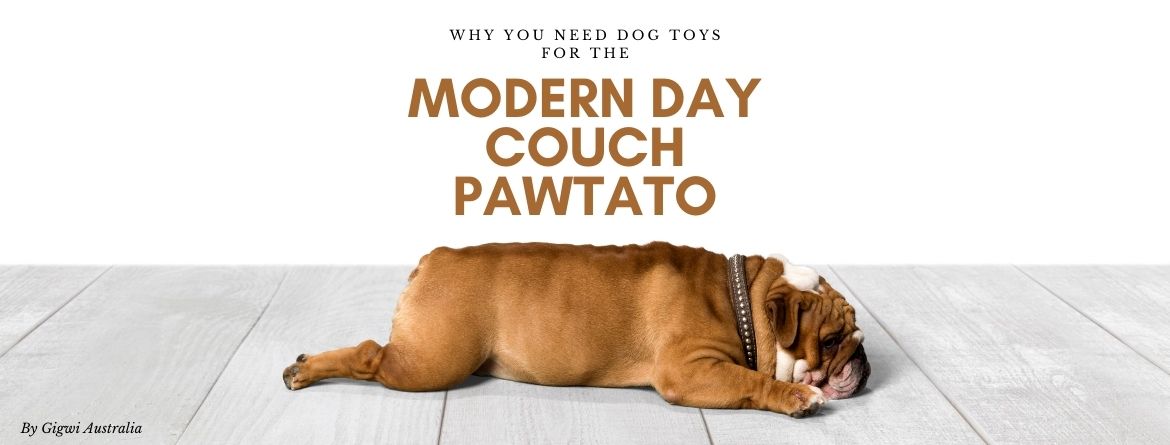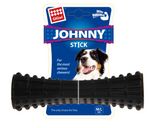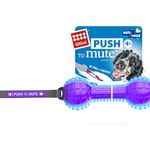14th August 2020
Source:Gigwi Australia
|
It is that little flutter of love, that irresistible face that sees us crack a smile, makes us look at our dogs not just as pets, but as a treasured family member. So, when it comes to caring for your four-legged friends you want to do the very best you can for them. Given that looking after a dog is not instinctively inherited or easily communicated like it is a child, you are often confronted with the daunting task of choosing the right food, medication and toys for your dog without ever being able to ask, “Do you like it?”. So how do you really determine what is best? You need to start at the beginning, particularly when it comes to choosing the right toys for your dog. When choosing a dog toy, you need to go back and understand the fundamental question, “Why do dogs need to play with toys?”. Domestic dogs have been working along side humans for thousands of years, originally bred specifically for hunting and farming protection. I often hear people say “We never had half these toys back in my day and my dogs were fine”, and whilst that might be true, the job description and lifestyle of the modern day pampered pooch has changed significantly over the last century. From active hunter or farm dog to a fluffy companion, a cute couch potato and provider of love and comfort. To stop us from all having to quit our jobs to hunt the land with our doggy companion, modern-day dog toys have emerged in their thousands to help entertain and train our furry friends. Dog toys serve a vital purpose in a dog’s mental development and can provide great physical exercise. They also help strengthen the human-animal bond, as well as being a powerful tool for behaviour modification. While admittedly your dog is never really thinking why they pull their favourite dog toy out of the pile, there are behaviours that drive them during playtime that we can use toys to stimulate. Let us take a look at some of the types of toys you can buy and why they work. |
|
|
|
Chew ToysChewing is a normal behaviour in dogs. It is instinctively built into them to keep their jaws strong and their teeth clean, as well as a stimulating form of exercise and a way to relieve stress and anxiety. In this way, chew toys are like the multi tool of the dog world. It is important that you provide your dog, whether it be a puppy or an adult, a variety of attractive and safe chew toys. As an added bonus, if you do this you will help teach them what is OK to chew and avoid them gnawing on the brand-new lounge or your favourite pair of shoes. Given the function of a chew toy, they prove to be a very popular choice amongst dog owners, and as such, the choice is endless. What is important when selecting a chew toy for your canine friend is the type of material it is made of. The primary function of a chew toy is to be inside a dog’s mouth. They gnaw or lick the toy and if it has toxins like BPA, Phthalates or Lead, the toxins can end up in the dogs blood stream without them even swallowing any piece of the toy. Increasingly, companies are moving towards using Thermoplastic Rubber (TPR), which is widely used in medical devices and children’s toys. Quality toys made with TPR rubber are BPA and PVC (which contain Phthalates) free, whilst still being durable against dogs’ teeth. Click Below For Chew Toy Range: |
Interactive ToysDogs, like humans, are very social animals. Driving interactive play between you and your dog, or them and their furry mate from down the road, is a way to not only positively cement the bond you have with them, but to also fulfill that need for social interaction that they have. There are a couple of interactive games you can play with your dog that will satisfy their deep-rooted instincts to search, chase, grab and tug. - Tug-of-war: As canines, your dog has a natural urge to grab and pull on things with their mouth, which comes from the act of hunting in the wild. A good old session of tug-of-war with your dog provides a highly interactive activity for both you and your dog, and a great form of mental and physical exercise. The best type of toys for this are those with rope, or a combination of rope/plush or rope/rubber that are made to provide a safe way for you to play with your dog in this way. - Fetch: The classic game of fetch, usually one of the first things that you teach your dog, right? Hunting and retrieving food is a behaviour that has been bred into domestic dogs over thousands of years, so much so that it is now something that is pleasurable and exciting for them. This is why fetch, whether it be a sturdy ball or a toy that you can toss, is a great form of physical exercise for them, as well as a way to build on the bond you have with your dog. Click Below For Interactive Toy Range: |
 |
Enrichment ToysWhilst this may come as a surprise to many of you when you look at that little lump at the end of your couch, dogs are thinkers, very inquisitive by nature and they love to hunt! They have a sense of smell that cannot be beaten. Food dispensing toys allow you to put food or treats inside them, and leave the dog to roll, nudge, shake and nibble until the food comes out. This requires time, patience and problem-solving skills and will help your pooch enjoy quiet time alone, naturally helping to solve boredom and stop them digging a hole in the lawn. A little “insiders trick” is to start giving part of their daily meal in a food dispensing toy, which works to both stop them inhaling their food in 5 seconds flat, as well as keep them entertained when you go to work. Click Below For Enrichment Toy Range: |
|
Plush ToysLet’s be real, a lot of you will have a dog that is in love with stuffed plush toys. They will carry them around everywhere they go, or sit there licking it, snuggled right up to it, or literally try and shake it to death. But have you ever though why they so obsessed? One theory is that a lot of dogs bred for hunting and retrieving like to have things in their mouth, it is something that is innate in their nature. Another reason could be they can really bite down and shake the toy around, almost like a simulated kill. Personally, I think there is a certain comfort and smell that surrounds a plush toy that encourages them to collect and play with toys just like a human child would do. It is important when selecting stuffed toys that you give your dog one that is safe, avoiding anything with plastic eyes or little pieces that can be chewed off as a choking hazard. Similarly to when you are selecting toys for a baby or toddler. |
 |
|
|
Tough Plush Toys with TPR RubberIf your dog is known to be more a killer than a lover when it comes to plush toys, but you don’t want them to miss out completely, you can increase the durability of the plush toy by finding toys that use a combination of plush and TPR safe rubber. Toys with rubber placed over the weak points, i.e. the seams, increases the toys chance of survival. Another choice is to go for something that has rope inside with plush exterior. The rope reinforces the toy and makes it a little more durable to those that are prone to be a little more on the destructive side. |
|
At the end of the day toys are an essential part of the modern day dogs life, and while the primary purpose that usually pushes you to invest in a new toy for your dog is exercise, there are so many other benefits. When it really comes down to it, toys are just FUN and they can offer a bit of extra excitement into both your dog and your own lives. There is no better feeling than watching your furry companion having fun.
Source: Gigwi Australia |
|
29th May 2020
Source:Lifewise Pet Nurtition
|
Holistic Petfood, as one of the latest marketing buzz words I am sure you have heard this term more than once recently, with every other new product released onto the market using the claim. Driven by consumer demand in Australia to only give the best to their four legged friends, the choice of ‘holistic’ foods to stock your shelves are endless. So how do you actually know if a food is holistic, or if it is used as a clever marketing strategy? Holistic is a term that has been commonly used in medicine to describe the concept of the whole being greater than the sum of the parts. Holistic food by definition, must nourish the body as a whole. Unfortunately, most pet foods carrying the holistic label claim, simply use the term to describe a food that has been made from natural ingredients. But making a food from natural ingredients in no way guarantees the food ingredients are appropriate for the animal being fed, nor does it guarantee the nutritional and therapeutic needs of the animal as a whole are being met. So, what does meet the true definition of a holistic food? Creating a food that actually meets the definition of “food as medicine” must meet two basic criteria. Firstly, the ingredients must be appropriate or sympathetic to the animal’s digestive ability, and secondly the nutrient profile must match the dog’s genetic requirement for nutrients at its particular life stage. Sympathetic ingredients: These are ingredients that the modern canine can digest efficiently and effectively and are typically the types of food that match the class of animal (carnivore, omnivore or herbivore), and are in keeping with the animal’s digestive enzyme production and gut structure. Unfortunately, many modern pet foods contain ingredients that are seen by the mainstream human population as being “super foods” but are not necessarily ingredients that can be efficiently and effectively digested by the dog. An understanding of the role the gut microbiome plays in the nourishment and wellbeing of the host animal also needs to be taken into consideration for a holistic food. In short, for the “whole” to be balanced, the gut microbiome must be balanced and that can only occur when a diverse supply of appropriate food ingredients in the correct proportions are contained in the food. Anything less than this will create disruption or a loss of species diversity within the gut microbiome, which in turn leads to those unintended health issues mentioned above. Balanced nutrients: Having the correct ingredients in the food still doesn’t guarantee the food will treat the dog holistically. Holistic nutrition demands the individual nutrients be contained in the food at the same levels as they are used by the body, so a holistic dog food will be built around a specific nutrient profile of proportionally supplied nutrients. Furthermore, this nutrient profile must be provided in strict ratio to the energy density of the food. So, it can be seen that making a holistic food is no simple task. Without a full and complete understanding of the requirements of the canine microbiome, coupled with a full and complete understanding of the inter-relationship of nutrients required by the modern dog, there is little hope of producing a truly holistic food. Despite the ever-increasing range of premium foods on the market, we are still seeing an extraordinary number of dogs with skin and gut sensitivity issues, the vast majority of which are directly related to poor diet or the use of biologically inappropriate ingredients. But not only are sensitivity issues on the rise, but evidence shows as many as one in every three dogs will experience cancer of some type during its lifetime. Using the points in this article, you and your staff can assist your customers with the daunting task of deciding the best food for their canine or feline friends, and help them steer away from the marketing buzz words in the category. A great example of holistically developed food is the Lifewise Range here. |
15th May 2020
Source: Bayer Animal Health
|
“My dog won’t stop scratching”, “My cat has a red rash on her skin and is losing some patches of hair”, “My poor dog is restless and itchy, he just looks so uncomfortable I need to do something for him!” Sound familiar? Scratching, biting, rubbing, constant licking, hair loss, red rash on the skin, thickened skin and scratches from self trauma are all signs and symptoms of Flea Allergy Dermatitis, commonly abbreviated to as FAD. Flea allergy dermatitis (FAD) is one of the most common skin conditions found in dogs and cats. Flea bites expose pets to flea saliva – which some pets become allergic to over time. This allergic reaction is known as flea allergy dermatitis, or FAD. FAD is an allergic skin condition that mostly affects pets aged over one year and commonly occurs in dogs and cats with underlying skin diseases like atopic dermatitis. Pets with FAD can damage their skin by constantly scratching, biting or licking, and this damage can lead to secondary infection. What does FAD look like? The most common sign of FAD in dogs and cats is intense itchiness, but there are others to watch for:
It's also important to look for damage to your pet’s skin that can lead to secondary infections (reddened, moist areas called “hot spots”) that will exacerbate the itching. How to Manage FAD in pets Bites from just one flea can be enough to trigger intense itching in a pet with FAD, and a vet may diagnose FAD even if fleas or flea dirt (flea faeces) aren’t visible. Minimising the number of flea bites is the most important part of managing FAD. You can control fleas year round with an effective, fast-acting product like Advocate®, Seresto®, Advantix® (dogs only)* or Advantage®, thanks to imidacloprid – the super active ingredient, which kills fleas on contact. This means that fleas don’t need to bite the pet and cause further irritation before the treatment takes effect. Once fleas come into contact with the pet, they are affected within 3-5 minutes. Reinfesting adult fleas are killed within 2 hours. All pets in the household should be treated whether or not they show signs of flea infestation. * Advantix – Do not use on cats. Learn More Learn how to recognise the signs of FAD, get proper treatment and prevent it from happening in the first place. For some more information check out the Advantage Petcare Website. Knowledgeable staff is one of the best ways to not only gain a consumers trust, it also builds loyalty to keep them coming back. Bayer offers great training programs on Accelerate, this allows you and your staff to increase your knowledge, skills and experience so you can offer the best advice, products and service to your customers Its free to sign up, check out this quick 15 minute course of FAD here to kick off the learning journey! |








.png)













